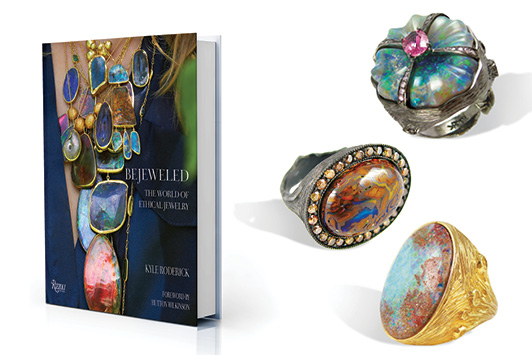
What does Sandy Leong —who creates sensual jewelry in 18-karat recycled yellow gold with ethically sourced Australian diamonds — have in common with Stella Flame, whose textured sterling silver and 18-karat gold cuff bracelets resemble leather? These designers, like the other 12 creators profiled in Kyle Roderick’s recently released
Bejeweled, can be defined as ethical jewelers (see box for the author’s full definition).
Roderick’s insightful and thought-provoking overview is a welcome contribution to the debate about what makes a piece of fine jewelry ethical. “Jewelry can be visually and poetically compelling, environmentally sustainable, and socially beneficial,” writes the journalist and curator of influential Instagram feed @bijouxreview.
Although the style of each featured designer is powerfully distinct, there are recurrent themes in their approaches. Roderick divides her survey of contemporary sustainable jewelry into four sections. Traditional jewels “embody folkways, philosophies, and culturally significant symbols”; classic jewelry reinterprets ancient forms and motifs; natural creations refer to the animal world and support for nonprofit organizations; and conceptual pieces associate linear and sculptural forms with philanthropy.
Bejeweled offers the opportunity to discover the rich inspiration, highly creative processes and deep thinking behind the work of designers as diverse as Pippa Small, Loren Nicole, Coomi, K. Brunini, Samira 13 and Ana Katarina. Alice Cicolini, Dewey Nelson, Anabela Chan, Karma El Khalil, ston and Joan Hornig are also in the spotlight.
The book celebrates not only the designers’ work, but also that of the artisans involved in the painstaking creation of their jewels. Through their dedication to ancestral traditions, these makers ensure crafts and technical knowledge are preserved and handed down.
Roderick shares some informative background about the designers — for instance, many of them didn’t start their professional journeys in the industry. They came from fields such as war reporting, finance and engineering, bringing further layers of cultural and sociological references to their workshops.
As for the stones used — with the notable exception of Chan, who has made a name for herself with her intricate lab-grown gem-set pieces — the designers all embrace natural, ethically sourced gemstones. For instance, a couple of the designers Roderick picked work with emeralds from Muzo Emerald Colombia, which has strict traceability practices, equal opportunities for women, and a safe working environment.
This elegant, beautifully illustrated book will appeal to Couture show-goers, fine art lovers and anyone interested in the hot topic of sustainable luxury.
Bejeweled by Kyle Roderick was published by Rizzoli New York.
rizzoliusa.com Article from the Rapaport Magazine - December 2019. To subscribe click here.